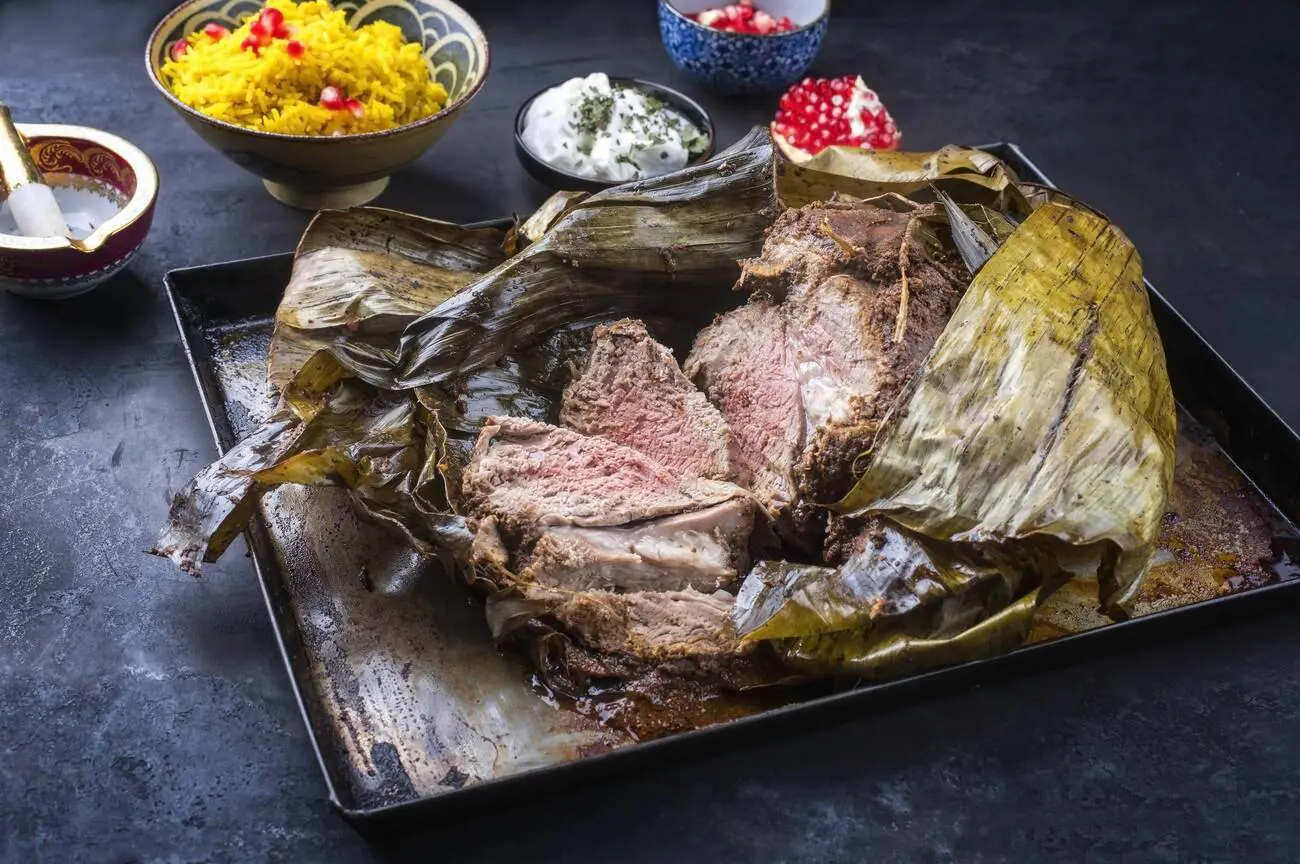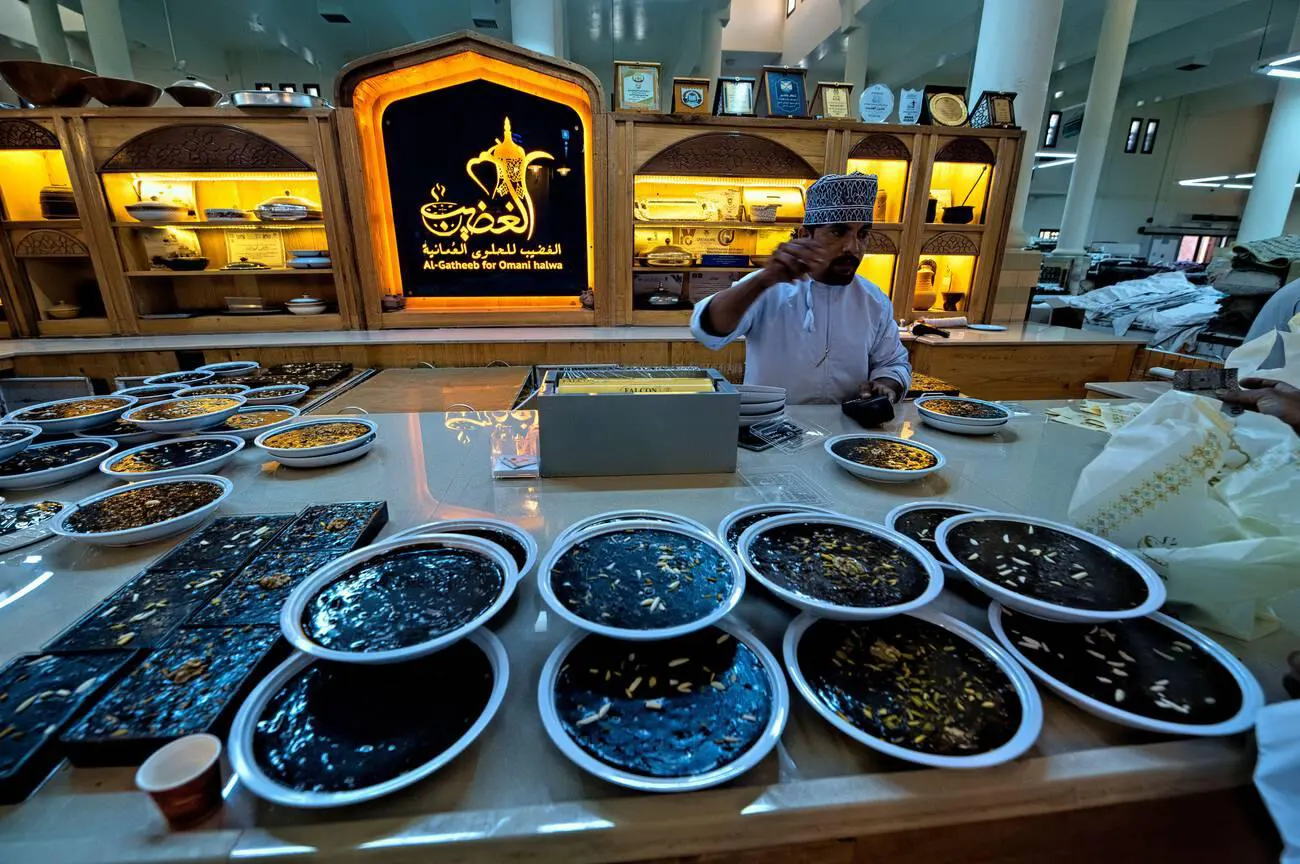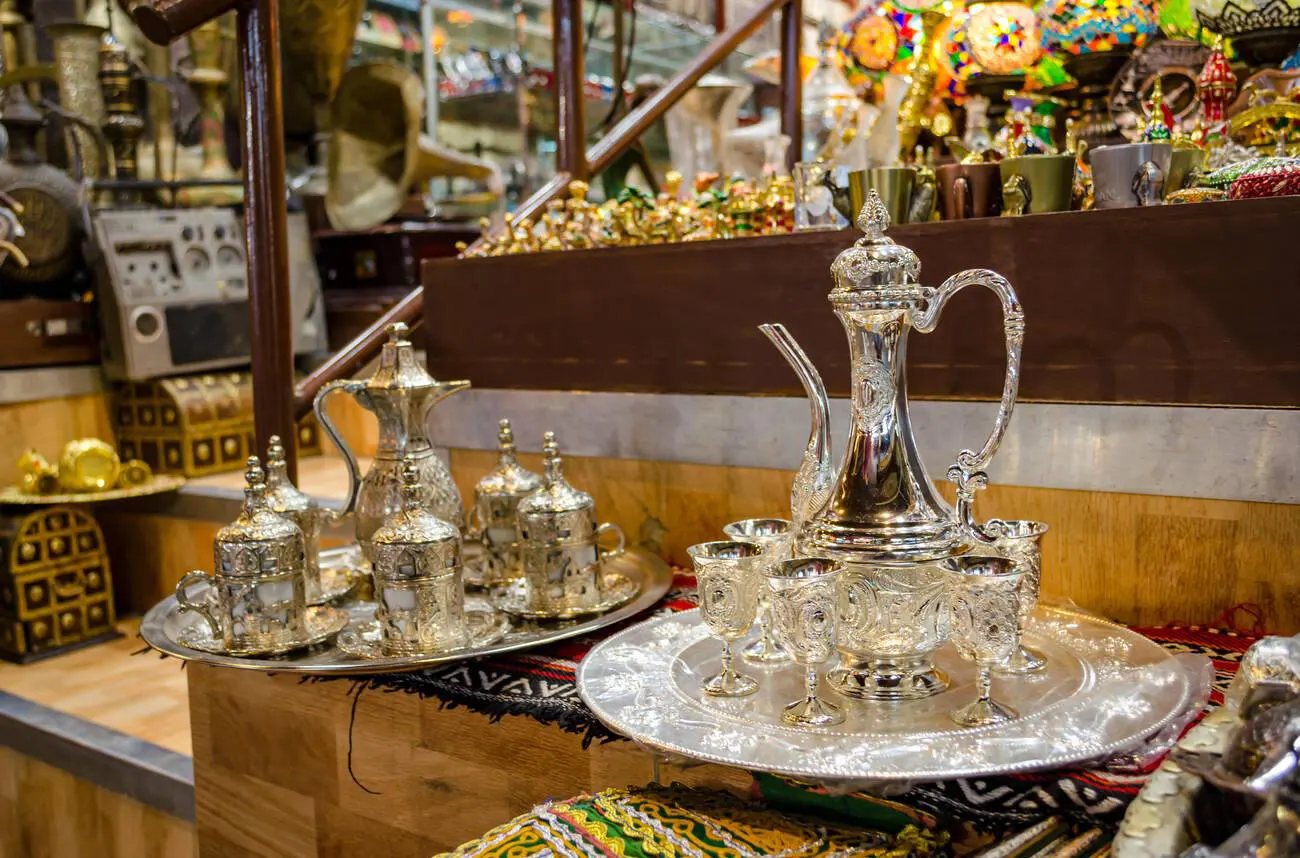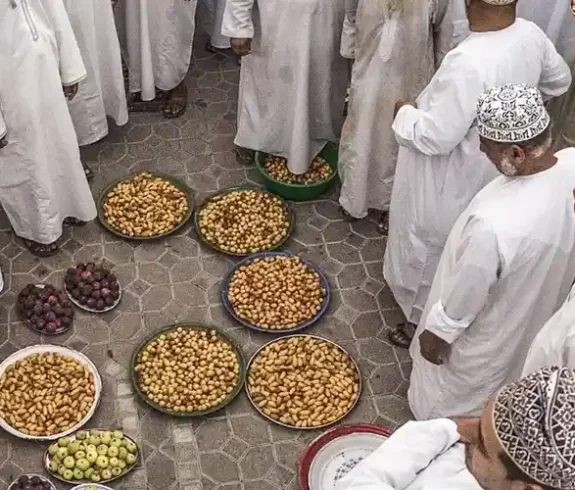The Cuisine of Oman presents an exciting fusion of flavors, reflecting the country’s prosperous trade and cultural connections history. It combines culinary influences from Arab, Persian, Indian, and East African traditions, resulting in a distinct and flavorful food culture. Over the centuries, Omani cooking techniques have evolved, blending these diverse elements into a unique and delicious culinary tradition.
The Role of Spices, Herbs, and Marinades in Omani Cooking
Omani food stands out for its vibrant and aromatic use of spices, herbs, and marinades, elevating ingredients’ natural taste. Here’s how these components shape the culinary experience:
- Spices: Omani food is a symphony of spices, with cardamom, cinnamon, saffron, and turmeric playing key roles. These spices, a legacy of Oman’s spice trading past, add a unique touch to every dish, making it a truly memorable experience.
- Herbs: Omani cooks frequently use fresh herbs like coriander, mint, and parsley to garnish dishes, adding a refreshing touch and vibrant color.
- Marinades: Meat and seafood dishes often feature marinades made with a combination of spices, herbs, and sometimes yogurt or citrus juice. These marinades tenderize the protein and infuse it with bold, rich flavors, making every bite memorable.
- Flavor Combinations: The thoughtful combination of spices, herbs, and marinades creates a complex yet harmonious taste that defines Omani Food. These layers of flavor ensure that each dish is a true reflection of Oman’s culinary heritage.

Traditional Omani Dishes: A Glimpse into the Cuisine of Oman
The Cuisine of Oman reflects a rich blend of flavors and techniques, showcasing the nation’s cultural wealth and culinary creativity. This overview introduces essential dishes epitomizing Oman’s diverse and intriguing gastronomic scene.
Shuwa: A Festive Lamb Specialty
- Marination: Chefs infuse lamb with a rich marinade of cumin, coriander, garlic, and cardamom, using oil or clarified butter as a base. They then wrap the lamb in banana leaves or palm fronds.
- Cooking Technique: Cooks place the wrapped lamb in underground sand ovens, slow-cooking it over hot coals for 48 hours. This traditional method infuses the lamb with a unique smoky flavor and renders it exceptionally tender.
- Serving Tradition: Shuwa is more than just food; it’s part of the celebration, often served during special occasions and festivals, symbolizing the communal spirit of Omani culture.
Majboos: The Aromatic Rice Experience
- Ingredients: Majboos, known as Kabsa, beautifully merges basmati rice with saffron’s golden hue and aroma.
- Variety: This dish adapts to various celebrations by featuring either lamb, chicken, or fish, each version spiced distinctively to complement the saffron-infused rice.
- Cultural Importance: Majboos is a testament to Omani hospitality. It is frequently prepared to honor guests and cherished as a household culinary staple.
Harees: A Homely Wheat and Meat Dish
- Composition: Harees uses a minimalistic recipe, combining wheat and meat (usually chicken or lamb) seasoned lightly with salt.
- Cooking Process: They gently cook the mix overnight to achieve a smooth, comforting porridge-like consistency, highlighting the dish’s soothing qualities.
- Occasional Significance: Prevalent during Ramadan and religious celebrations, Harees embodies the simplicity and sustenance valued in Omani food traditions.
Mashuai: A Celebration of Seafood
- Preparation: Before cooking, they season the kingfish with a blend of lemon, turmeric, and coriander.
- Method: They grill or roast the fish, often over an open flame, to highlight its natural flavors.
- Accompaniments: Typically served with lemon rice, Mashuai’s zestful taste complements the subtle spiciness of the rice, offering a balanced meal.
Omani Bread (Rukhal): A Daily Delight
- Description: Rukhal is a light, round bread made from a straightforward mix of flour, water, and salt, cooked on a hot surface until crisp.
- Versatility: Whether paired with honey or cheese, Rukhal is adaptable for any meal, serving as a delicious accompaniment or a simple snack.
- Cultural Significance: A daily staple in every Omani household, Rukhal represents the ingenuity and simplicity of traditional Omani baking practices.
Savoring the Sweet Delights of Omani Desserts
People celebrate Omani cuisine for its delectable desserts and savory dishes. Essential desserts like halwa and various date preparations are pivotal in the region’s cultural and culinary narratives. This exploration highlights these essential sweets, enriching the Omani food experience.
Halwa: A Quintessential Omani Treat
- Composition and Method: Crafted from sugar, rose water, and an assortment of nuts, Omani Halwa is a unique, gelatinous dessert. The inclusion of cardamom and saffron elevates it to a sumptuous treat.
- Cultural Importance: The offering of halwa symbolizes Omani hospitality. It is typically served after meals and prominently featured during festive and religious occasions, underscoring its significance in Omani traditions.
- Enjoyment Tips: Halwa is best enjoyed warm or at room temperature. It pairs wonderfully with traditional Omani coffee, which complements its sweetness.
Dates: A Cornerstone of Omani Sweet Treats
- Diversity: Oman is proud of its diverse array of dates, each variety noted for its distinct taste and texture. From the juicy Khalas to the dense, chewy Fard, these dates mirror the nation’s rich agricultural legacy.
- Symbolic Significance: In Omani culture, dates represent hospitality and generosity. They are a customary dessert and a vital dietary element, especially during Ramadan when they often break the fast.
- Culinary Applications: Dates are versatile. They are enjoyed as a standalone snack and incorporated into various Omani dishes. Cooks may fill them with nuts, puree them into smoothies, or simmer them into luscious sauces to enhance meat dishes.

Common Ingredients and Flavors in the Cuisine of Oman
The Cuisine of Oman celebrates its deep-rooted use of spices, unique ingredients, and cultural influences that foster a dynamic culinary scene. Traditional Omani food harnesses a spectrum of flavors that echo the nation’s historical engagement in the spice trade and its strategic geographical position on ancient trade routes. Let’s delve into the essential ingredients and flavors of this distinctive cuisine.
Essential Omani Spices: Building the Flavor Base
Omani Food extensively employs a range of spices that introduce depth and complexity to daily meals and celebratory dishes. Among the most frequently used spices are:
- Cumin: This spice is a cornerstone in many Omani dishes, providing a warm, earthy essence. It’s commonly mixed with spices to season meats, rice, and stews.
- Coriander: Both fresh leaves and ground seeds of coriander are pivotal in Omani kitchens. While the fresh leaves are a vibrant garnish, the ground seeds impart a mildly citrusy flavor to various traditional recipes.
- Cardamom: Known for its sweet, aromatic properties, it is a favorite in savory dishes and desserts such as spiced rice and sweets.
- Saffron: Celebrated for its subtle floral notes and striking color, saffron is crucial in Omani cooking. People typically use it to enrich rice dishes like Majboos and to flavor various desserts and drinks.
Frankincense and Rose Water: Distinctive Elements in Omani Cuisine
Frankincense and rose water distinguish Omani Food from other regional culinary traditions. Omani kitchens use these ingredients as staples in culinary preparations and traditional remedies.
- Frankincense: Reflecting Oman’s rich trading history, cooks sometimes add frankincense to dishes for its unique flavor, but more frequently, they burn it to perfume dining spaces. Additionally, its essence is infused into beverages, providing a distinctive aromatic quality.
- Rose Water: This ingredient is crucial in defining the flavor profiles of Omani desserts and drinks. Frequently added to sweets like Halwa, rose water offers a gentle floral accent. It is also a popular beverage addition, providing a refreshing note during the warmer months.
Dates and Coffee (Kahwa): Pillars of Omani Dietary Tradition
Dates and coffee represent critical elements of sustenance and hospitality within Omani food culture.
- Dates: More than just a snack, dates symbolize hospitality in Oman and are commonly presented to guests with Omani coffee. Available in various textures and flavors, from soft and sweet to firm and chewy, dates are a versatile and healthful component of the Omani diet. Chefs incorporate them into various dishes, particularly sauces and desserts.
- Kahwa (Omani Coffee): In Oman, people traditionally brew Kahwa with cardamom and occasionally enhance it with saffron, making it a rich, aromatic experience and a fundamental aspect of social interaction. It is typically served in small cups alongside dates to express a warm welcome to guests.
Omani Coffee and Hospitality: A Tradition of Warmth and Generosity
The Cuisine of Oman is about flavors, ingredients, and the deep-rooted cultural practices surrounding food. Central to these traditions is Omani food, where coffee (Kahwa) and dates play a crucial role in expressing hospitality. In Oman, serving food is more than just a meal; it is an act of warmth, respect, and connection, especially when welcoming guests.
The Cultural Significance of Serving Omani Coffee (Kahwa) with Dates
In Oman, Kahwa holds a special place as it is not just a beverage but a symbol of hospitality. Omani coffee is traditionally brewed with cardamom, sometimes with saffron, giving it a rich and aromatic flavor. It is typically served in small cups, often without sugar, making its bold flavor stand out.
With every cup of Kahwa served, there goes an unending supply of dates. Such is Oman’s custom in which coffee and dates exemplify hospitality. Then again, it is through bitterness that honey is balanced and made sweet. This only means that while the Omanis consume many fruits like dates every day, they don’t do so because they lack other options but because fruit products are highly valued food items promoting good health among humans.
In Omani culture, serving coffee and dates to visitors is a familiar gesture of goodwill. Guests are often greeted with this offering immediately upon entering a home, regardless of the time of day, making it a deeply ingrained tradition. Sharing Kahwa and dates fosters connection, conversation, and trust, showing Omanis the importance of relationships.

The Role of Hospitality in Omani Culture
Hospitality is a core value in Omani society, and food is central to this tradition. Omanis believe in treating guests with the utmost respect and sharing food to extend kindness and generosity. Whether in a simple home or a grand setting, guests are always treated to a wide array of dishes that reflect the richness of Oman’s cuisine.
It is customary in Oman to serve various Omani food when hosting guests, ranging from spiced meats and rice dishes like Majboos to fresh seafood and traditional bread. The host takes great pride in ensuring the guests feel comfortable and well-fed, often preparing more food than needed to symbolize abundance and care.
Serving food in Oman is a communal and social activity. Everyone shares the meal, reinforcing bonds and creating an atmosphere of warmth and friendliness. The emphasis on hospitality extends beyond homes, as you can expect the same generosity in restaurants, festivals, and public gatherings.
The Role of Seafood in the Cuisine of Oman
The Cuisine of Oman benefits immensely from the country’s extensive coastline, which provides a bountiful seafood supply. This proximity to the sea has shaped Omani food into a rich culinary tradition where dishes like kingfish, tuna, and shark play a central role. These seafood staples offer a fresh ocean taste and reflect Oman’s cultural affinity with the sea.
Oman’s Coastal Bounty: A Seafood Haven
This geographical positioning, bordering Oman on the Arabian Sea, Gulf of Oman, and Arabian Gulf, leads to plentiful seafood. The result is a constant fish supply, a significant part of Omani food. Here’s how the Cuisine of Oman utilizes different types of seafood:
- Kingfish: Chefs often consider kingfish the star of the Omani seafood platter. Chefs prize it for its firm texture and mild flavor. Kingfish is commonly grilled, served as steaks, or cooked in a spicy curry that pairs wonderfully with rice.
- Tuna: Tuna is another famous catch frequently used in Omani dishes. It’s versatile and enjoyed fresh in salads, grilled, or preserved. Tuna fish curry is a beloved dish that showcases the rich spices of Omani cooking.
- Shark: Traditionally, shark meat holds a special place in Omani Food. Chefs typically use shark in dishes like Mashuai, roasting it whole and serving it with lemon rice and a tangy sauce.

Practical Tips for Enjoying Omani Seafood
- Explore Local Markets: For the freshest seafood, visit the local fish markets early in the morning. Here, you can experience a variety of Oman’s seafood and see the day’s catch fresh from the ocean.
- Try Traditional Dishes: To truly appreciate Omani food, taste traditional seafood dishes at local restaurants. Dishes like grilled kingfish, tuna curry, and shark soup offer a genuine flavor of Omani culinary heritage.
- Cooking Techniques: Omani seafood is often cooked with minimal fuss to highlight the fresh flavors. Grilling or roasting is preferred, with spices like saffron, turmeric, and cardamom enhancing the fish’s natural taste.
- Seasonal Varieties: Pay attention to the seasonal availability of different types of fish. Enjoying seafood when it’s in season means the dishes will be at their freshest and most flavorful.
Influence of Surrounding Regions on the Cuisine of Oman
The Cuisine of Oman is a rich tapestry woven with flavors from its surrounding regions. It showcases a delightful blend of Indian, Persian, and African culinary traditions. This fusion has enriched Omani food and highlighted its diversity and adaptability over centuries. This article explores how these influences manifest in Omani dishes, particularly curries, stews, and rice-based meals.
Indian, Persian, and African Influences in Omani Dishes
Omani cuisine’s proximity to various cultures and trading histories has led to a unique culinary fusion:
- Indian Influence: Oman’s historical trade relationships with India have introduced a variety of spices and cooking techniques, particularly in the realm of curries. Spices such as turmeric, cardamom, and cumin, pivotal in Indian cooking, are now staples in Omani kitchens. Dishes like chicken curry and biryani, which feature rich, spiced gravies and seasoned rice, are popular among locals.
- Persian Influence: Persian flavors in the Cuisine of Oman are evident through saffron and dried limes, which taste distinctive to stews and rice dishes. Persian cooking techniques, such as slow-cooked stews (similar to the Persian ‘khoresh’), have been adapted into the Omani culinary repertoire, enhancing the flavor profiles of traditional Omani meals.
- African Influence: Given Oman’s historical connections with East Africa, it’s no surprise that African ingredients and methods have found their way into Omani pots. Coconut milk and fish are commonly used in coastal Omani dishes, reflecting the Swahili Coast’s impact on Omani Food. These ingredients are often used in stews and rice dishes, providing creamy textures and hearty flavors.
The Significance of Rice in Omani Cuisine
- Staple Ingredient: Rice is a cornerstone of Omani Food. It is the foundation for many meals, echoing similar culinary practices in neighboring Gulf countries.
- Variety of Dishes: In Oman, rice is not just a side dish but the main component of many meals. From the saffron-infused rice in Shuwa to the spiced layers in Majboos, rice dishes in Oman reflect the region’s love for well-seasoned, hearty meals.
- Cultural Connection: Preparing rice-based dishes in Oman involves elaborate cooking methods often shared across family generations and community gatherings, symbolizing unity and tradition.
Exploring the Vibrant Street Foods and Festive Culinary Traditions of Oman
The Cuisine of Oman showcases a profound connection to the nation’s cultural heritage, evident in both the lively street food scene and the elaborate culinary customs of festive occasions. This guide delves into the famous street foods and the distinguished dishes that mark celebrations such as Eid and weddings, underscoring the diversity and richness of Omani food.
Delights of Omani Street Food
The streets of Oman offer a sensory feast filled with enticing aromas and flavors that provide a glimpse into the local culinary culture. These popular street foods merge traditional tastes with the convenience of quick, delicious servings:
- Shawarma: This beloved street food features chicken, lamb, or beef marinated and slow-cooked on a rotating spit. Thinly sliced and tucked into flatbread with various sauces, vegetables, and pickles, shawarma offers a fast and fulfilling meal.
- Samosas: Favored particularly during Ramadan, these crispy, deep-fried pastries are stuffed with spiced meats, vegetables, or lentils, offering a flavorful and satisfying snack.
- Grilled Meats: A common sight on Omani streets, vendors serve a range of spiced, grilled meats, including chicken, lamb, and fish. These meats, marinated with traditional spices such as cumin, coriander, and turmeric, are perfectly grilled and often accompanied by flatbreads or rice.
Celebratory Foods for Special Occasions
In Oman, culinary traditions play a pivotal role in festivals and celebrations, uniting families and symbolizing the essence of Omani hospitality.
- Shuwa: A signature dish for festivities like Eid and weddings, Shuwa involves marinating lamb or goat in an aromatic spice mix, wrapping it in banana leaves, and slow-cooking it in underground sand ovens for up to two days. This technique yields exceptionally tender and flavorful meat shared among loved ones.
- Halwa: Omani Halwa frequently appears at weddings and special gatherings. Cooks craft this dessert using sugar, rose water, and nuts, creating a treat with a distinct floral and nutty flavor. It represents hospitality, and people traditionally serve it alongside Omani coffee.
- Majboos: Like biryani, this fragrant rice dish is a celebration staple. Chefs prepare it with basmati rice, saffron, and chicken, lamb, or fish, infusing all ingredients with various spices.
- Dates and Coffee (Kahwa): A traditional welcome for guests involves serving dates and Kahwa, a pairing that epitomizes Omani generosity and is fundamental during any special occasion.
Tips for Experiencing Authentic Omani Cuisine
- Visit Local Markets: To experience authentic Omani street food, visit local markets where shawarma stands, samosa carts, and grilled meat vendors offer a variety of flavors.
- Participate in Festivals: To fully engage with Omani festive foods, make your visit coincide with Eid or accept an invitation to a local wedding. These events are perfect for savoring dishes that capture the spirit of Omani food.
- Dine at Traditional Cafes: Experience the traditional flavors of Omani halwa and Kahwa at local cafes. Chefs serve these delights daily, offering a warm glimpse into the heart of Omani hospitality.
Dining Etiquette in Oman: Embracing Traditional Practices
Oman’s cuisine is celebrated not just for its flavorful dishes but also for the traditional dining practices that accompany each meal. Understanding proper dining etiquette is crucial for anyone eager to deeply appreciate Omani food and its cultural roots. The customs of dining in Oman embody respect, hospitality, and a deep sense of tradition, transforming every meal into a shared, meaningful gathering.
Traditional Methods of Serving and Eating Meals
In Oman, the traditional method of serving meals pays homage to age-old customs. In an Omani home, hosts typically invite guests to sit on the floor, emphasizing the values of humility and community. They place large platters of food in the center, enabling everyone to share the same dish and fostering a communal atmosphere.
- Sitting on the Floor: Meals are typically enjoyed while seated on the floor, often on cushions or rugs. This seating arrangement highlights the significance of family and community, fostering intimate interactions and shared dining experiences.
- Using the Right Hand: In Omani culture, eating with the right hand is a sign of respect. Although some settings might offer cutlery, traditionally, diners use their fingers to scoop up food, often assisted by flatbreads like Rukhal. Using only the right hand for eating is essential, as the left is traditionally considered impure.
- Demonstrating Hospitality and Generosity: Omani hosts are known for their generous hospitality. They often serve copious amounts of food to ensure guests are delighted. This generosity reflects a core value in Omani culture, encouraging guests to eat heartily.




